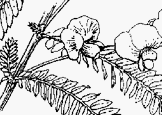
Abstract | Committee | Topics | Documents
I passed my qualifying exam on November 16, 2007. In the Energy and Resources Group, the qualifying exam is a three-hour oral test of the student's subject knowledge (in three topics of their choice) as well as a defense of a 25-page dissertation prospectus. It is the only formal milestone before the completion of the Ph.D.
Below is an abstract of my dissertation proposal and a summary of my topic areas, followed by several documents that go into much more detail. Since my qualifying exam is now over (whew!), all subsequent work will be posted on my dissertation page.
Can agroforestry increase reliability of subsistence agriculture under future climate in southern Africa?
Dissertation prospectus Abstract Agroforestry - the integration of trees into farm landscapes - has been promoted throughout the developing world as a solution to many environmental and socioeconomic challenges. Now, with the advent of global climate change, agroforestry is being proposed as a carbon sink for climate mitigation. But it is still unclear how climate change might alter the effectiveness of agroforestry systems from a farmer's perspective. Some agroforestry practices may help farmers adapt to a warmer, drier, increasingly variable climate. Other agroforestry practices may become a liability, as trees compete with crops for limited water. For my dissertation, I will perform field experiments in Zambia and Malawi to determine how the yield of three different agroforestry system designs - improved fallows, relay intercropping, and hedgerow intercropping - is likely to change under future climate. My primary approach will be direct manipulation of ambient rainfall (via rainout shelters) to simulate the drier conditions expected in coming decades. In addition to measuring grain and biomass yield, I will measure the physiological parameters of the plant/soil system in order to clarify mechanisms of competition or facilitation. As a complement to this manipulation experiment, I will examine data sets from previous and ongoing agroforestry experiments in the region, and compare yield and water-use efficiency during dry and wet years. As a distinct but interdependent part of my dissertation, I will use these data to improve the ability of WaNuLCAS, an agroforestry simulation model, to predict the behavior of these agroforestry systems under future climates. My overall goal is to provide information that will be useful to smallholders, land-use planners, and policymakers in southern Africa and throughout agricultural regions in the tropics. |
| |
Committee members:
Topics for qualifying exam:
| Dissertation prospectus
(37 pages): |
Reading list
(14 pages): |
Research presentation
(38 + 29 slides): | ||
|---|---|---|---|---|
| Adobe PDF
564 KB |
Adobe
PDF
236 KB |
Microsoft PowerPoint 5.9 MB |
||
| HTML (not for printing) |
HTML (not for printing) |
(Note: If copying any images from this presentation, please use proper attribution.) |
| |
|
|
Last updated February 7, 2008.